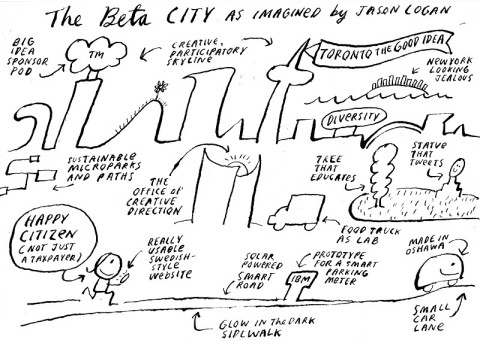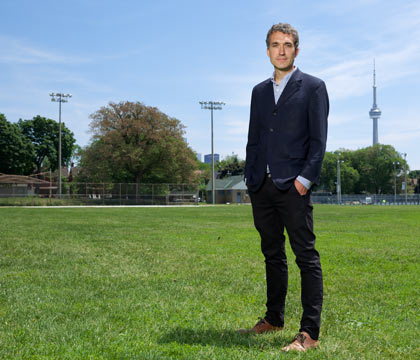Not long ago, Jason Logan found himself discussing the problem of bike lanes with editor-writer David Berlin. During the conversation, Berlin offered up an out-of-the-box idea that intrigued Logan, a creative director who has worked for numerous magazines and now runs his own studio. Why not repurpose Toronto’s downtown lanes and alleyways to serve as a bike path network?
Logan (BA 1997 Victoria) had more than just a cyclist’s interest in what would surely be a controversial proposal. He’s launched a campaign to persuade the city to establish an “office of creative direction,” an interdisciplinary “lab” that would work with the chief planner and council to facilitate innovative approaches to tenacious problems.
This city creative director (he’d take the job) would serve as a kind of urban translator between “dreamers” among the public on the one hand, and bureaucrats and elected officials on the other, many of whom prefer to say “no” instead of embracing visually inspired urban design and a creative approach to city planning. “That’s the true gap in Toronto,” says Logan. “I don’t think there’s any leader at City Hall thinking about the creative aspects of shaping a city.”
Earlier this year, he began talking up his plan in the media and set up a digital campaign, including an e-petition calling for the position to be created following the October election. Despite positive feedback from a few city councillors, he doesn’t want to tie the idea to a single mayoral candidate.
Logan was inspired by other cities. After Mexico City appointed Gabriella Gomez-Mont to set up an urban “laboratory” last year, for instance, she invited a wide array of creative professionals to tackle what Logan calls “really hardcore problems” – among them, the derelict and dangerous spaces lurking beneath the megacity’s highways and bridges.
The outcome: a new economic development program that allows upstart businesses to access those spaces inexpensively, on the understanding that part of the land will be set aside for civic or public uses such as parkettes, playgrounds and food stalls. Today, Logan says, the areas are becoming urban places that attract people and commercial activity.
For Toronto, Logan believes a civic creative director should focus on the subject that bedevils the city right now, which is congestion. The way forward, he argues, may well be to inject some right-brain thinking into an arena long dominated by left-brain types.
Logan wants graphic artists, poets, historians, doctors, computer programmers and even chefs to enliven a stalled debate with their own brand of creativity. As he puts it, “I’d bring some unexpected characters to the table.”

Recent Posts
U of T’s Feminist Sports Club Is Here to Bend the Rules
The group invites non-athletes to try their hand at games like dodgeball and basketball in a fun – and distinctly supportive – atmosphere
From Mental Health Studies to Michelin Guide
U of T Scarborough alum Ambica Jain’s unexpected path to restaurant success
A Blueprint for Global Prosperity
Researchers across U of T are banding together to help the United Nations meet its 17 sustainable development goals







2 Responses to “ A Creative Director for Toronto? ”
Jason's sketch of the city struck me as interesting. I like the idea of creating a new office to explore these problems.
I love this idea and it's long overdue. I've worked and lived in five cities globally as well as the city of Vancouver. On top of that, as a traveller and photo-journalist, I have visited well over a hundred cities worldwide. Not only does Toronto urban planning lack creativity, it underscores the fact that we are still a megacity under the "Toronto" flag which doesn't usually mean anything tangible to a lot of us who live here. What lasting impression of this city does a visitor of Toronto leave with? The Rogers Centre/Aquarium/Roundhouse/CN Tower price gouge? A few parks that are kilometres away from the downtown hub of hotels and restaurants?
As for Torontonians, commuters who come in from the suburbs are happy to get in and get out during the week, as quickly as possible, and not without complaints. Their weekends are spent not in the city, but rather in leafy neighbourhoods or shopping malls far from the boundaries of Toronto city limits. Far from the congestion, noise, pollution, homelessness, and lack of beautiful, inviting public spaces that characterize the densely populated core of the city.
This city needs to find its brand identity as the cultural hub that it is, so locals and visitors alike can get a true sense of what Toronto stands for and how it fits into the fabric of Canada.